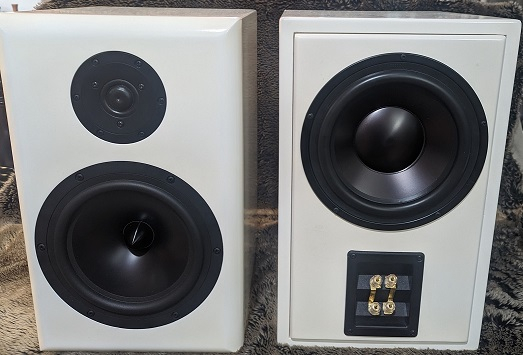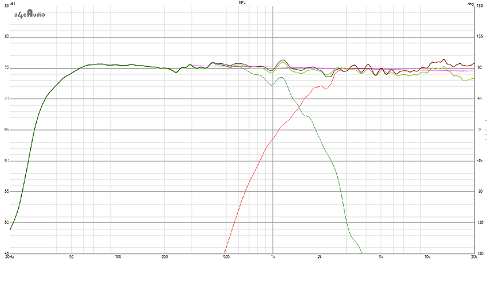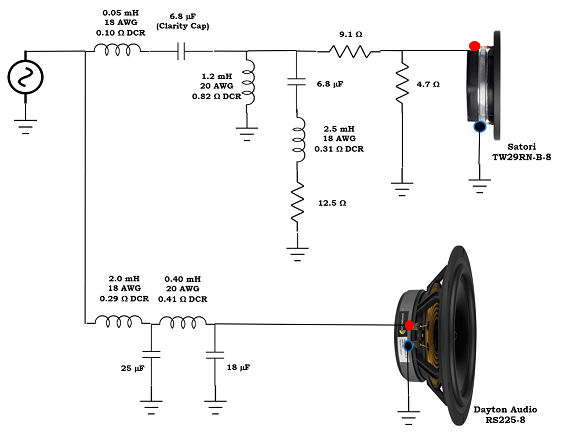Site Links
Howdy, Stranger!
It looks like you're new here. If you want to get involved, click one of these buttons!
Quick Links
Categories
In this Discussion
Who's Online (0)
Bosi 225 - A 2023 InDIYana Build - Satori TW29RN-8 & Dayton Audio RS225-8 (Isobaric)
Here is a write-up for my Bosi 225 speakers attached below. These came in 1st place in the 2023 Tweeter Yoga theme competition. While I'm happy about that, I'll gladly admit that there were many really good speakers and the differences between some were pretty miniscule.
I tried to go into some detail on the thought process and some of the decision making. I think most MAC members are veteran speaker builders, so I'm not sure how much of that is interesting, but I wrote it more for the Tech Talk crowd and people who are even more of a newbie than myself.
As has been said in other threads, the get together seemed particularly good this year and the variety and quality of the speakers is amazing to me. Thanks to Ben, Chuck and anyone else "behind the scenes" for all the hard work.
Highlights:
Tweeter: Satori TW29RN-B (8)
Woofer: Dayton Audio RS225-8 (x2 Isobaric)
Passive Radiator: Dayton Audio DSA215-PR
Dimensions: 10.5(W) x 17.0(H) x 12.125(D)
Volume: Gross volume 0.89cf (25L). Net volume seen by woofers approx. 0.67cf (20L)
Tuning: Fb = 33hz. F3=35hz per WinISD (38/39hz per my microphone and nearfield merging)







Comments
These sounded fantastic. Smooth, liquid highs; there was something very special about the sound coming from those Satori tweeters. Voices were non-resonant, soundstage was very lifelike and three dimensional. And the isobarik woofers plus PR system really hit the low notes with authority. I think you really nailed it with this speaker.
Wonderful design, even if they were for a supposed flawed theme build, they are a fantastic speaker. That's the way a two way 8" speaker should sound. Congratulations
Nice write up. Very detailed info on the pros and cons of isobarik 2 ways. There was a gentleman by the name of John Cockroft, who published several articles in Speaker Builder magazine on isobariks back in the 1980's and 90's. His conclusion was that the outer isobarik woofer is isolated from internal box resonances because it only sees the small tunnel between the woofers. Also, since the cabinet surface area is cut in half, there is much less delayed acoustical energy coming from the box itself.
Great write up. But just to be clear: The series inductor in the tweeter crossover is 0.05 mH (as noted in the write up) and not 0.5 mH (as shown in the schematic), right?
Well, crap. You are correct of course, I'll fix that, hopefully I can change the attachment in the original post.
That is interesting. I had a few conversations over the weekend about that and saw it as a possibility when researching online but didn't realize there were any formal articles/studies.
I am not allowed to work on speakers until my kitchen remodel is complete. For the Meniscus/CSS event in Grand Rapids I plan to build a tower version in twice the volume with a single driver, and probably use Paul Kittinger's MLTL model from his RS Duets. I'll build an identical tunnel as in the isobaric version but rather than have a 2nd driver attached to the back, put a panel of peg-board that allows it to share the internal air volume. Maybe they can play back-to-back to see how different the real isobaric sounds. (The other difference is I'll use the SB29RDCN because I have two extras from the CLFS (Charlie Laub Fire Sale) and am not about to buy a pair of the TW29RN's at retail price.)
Congrats on the win! What an ingenious idea to double up on the RS225 to cram it into a 20L box.
After a decade it’s still a top performer; short of a Revelator or Purifi money.
What was your favourite speaker?
And do you have any ideas why you won?
Does it really take 4 times the amp power applied to an Isobaric (parallel coils) alignment than that of a single driver to obtain the same SPL?
I just modelled a pair of MCM-5670's Isobaric and that's what the SPL graph indicated . . .
It think it takes 2 times the power to drive parallel coil isobariks, not 4 times, to achieve the same SPL.
WinISD or I are not doing something correctly then, as I get 96 db @ 65 Hz with 20W into a single MCM-5670 and 96 DB@ 65 Hz with 80W into an isobaric parallel pair . . . on the SPL chart option.
Okay, both of you are correct.
In terms of Voltage Sensitivity, Isobaric is the same as a single driver.
In terms of Power Efficiency, Isobaric takes a -3dB hit over a single, or needs twice the power.
They are NOT the same thing. 2 parallel drivers is +6 for VS, and +3 for PE.
Let's just drop the confusion by not looking at Power-Efficiency in the first place, and going with Voltage-Sensitivity like we always do to match output levels. Then this is of no consequence or confusion.
InDIYana Event Website
I'm not 100% sure, but I don't think WinISD does the power correctly for isobaric.
I always liked how this guy explains it. Only useful info based on parameters without confusing voodoo/fluff.
Unfortunately he doesn't specify past "spl sensitivity", but it seems he is talking about power (db@1w,1m) instead of voltage.
https://youtube.com/watch?v=BdF7nTU_QOQ
I think the actual "winning" is a good amount of luck. If we would have played the final speakers in a different order and 6 to 8 people sat in different spots, it wouldn't be a surprise if a different speaker won.
As far as why they did "well", I have a conjecture. Most/many of the people in the room are sitting at tweeter axis, with the speakers toe'd in, with 3 minutes of tracks specifically meant to test the technical capabilities of the speaker. My speakers had a VERY flat frequency response, which may sound clinical in the long run but we are all sitting there concentrating for 3 minutes on the detailed sounds. (Although I have been using them and don't think they actually sound "clinical".) They had an F3 around 38hz so could handle the bass tracks. Some combination of the PR, isobaric tunnel, and cabinet construction eliminated the normal "boxy" sound. And the Satori TW29RN is an awfully good tweeter.
Do you have any build pictures showing how you did the isobaric setup?
In the attached .pdf, Dave...
InDIYana Event Website
Dave, I know that wolf answered that they are in the PDF from post #1. I hope that the pics make it clear, but I have to admit when I went to put the write-up together and went to get the pics from my phone I didn't have as many as I thought. If you have any questions, feel free to ask me here or via PM.
Crap, I didn't even see the little PDF linky box.
Thanks!
Thanks for your response. You may be humble, but my theory is thiat. A it's a good design. By that I mean major flaws in the box driver selection or crossover. But what also helps is an impressive design.
And by that I mean that you used the design rules to your advantage. Cramming two woofers isobaric mounted into one box. Everyone has probably heard the RS225 by now. so to get that much out of a 20L box probably stunned more than one person because they are used to hearing it in 40L. Did you tell people that it was an isobaric design?
The other thing is the apparent low cost. Of course the RS225 are more expensive now than before (like everything) but they advantage of being a somewhat of a bargain. So you cram two into a box without breaking the banck.
Try that with a Revelator, which is what you need to step up to, if you want a significantly improved 8" midbass.